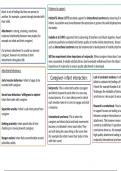Summary
Summary Sheets (COMPLETED) for 'ATTACHMENT': Psychology A-level
- Module
- Attachment
- Institution
- AQA
**THIS DOCUMENT EXCLUDES INFORMATION ON 'ROLE OF THE FATHER.'** This document provides a digital summary sheet (created on powerpoint) for every module within the 'Attachment' topic of Psychology A level. Each summary sheet provides in varying detail an outline (AO1) and 3-4 evaluation points (A...
[Show more]



